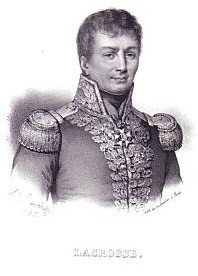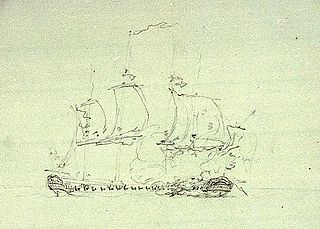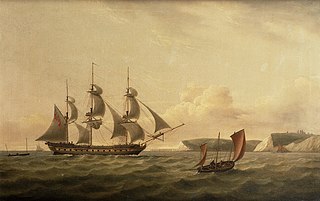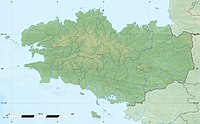
Admiral Edward Pellew, 1st Viscount Exmouth, GCB was a British naval officer. He fought during the American War of Independence, the French Revolutionary Wars, and the Napoleonic Wars. His younger brother Israel Pellew also pursued a naval career.

HMS Indefatigable was one of the Ardent-class 64-gun third-rate ships-of-the-line designed by Sir Thomas Slade in 1761 for the Royal Navy. She was built as a ship-of-the-line, but most of her active service took place after her conversion to a 44-gun razee frigate. She had a long career under several distinguished commanders, serving throughout the French Revolutionary Wars and the Napoleonic Wars. She took some 27 prizes, alone or in company, and the Admiralty authorised the issue of four clasps to the Naval General Service Medal in 1847 to any surviving members of her crews from the respective actions. She was broken up in 1816.

The action of 6 November 1794 was a naval engagement during the French Revolutionary Wars. Two British ships of the line, HMS Alexander and HMS Canada were intercepted while returning to Britain through the Celtic Sea by a large French squadron. The French squadron had sailed from Brest in search of an inward bound British convoy in October, but instead encountered the two British ships returning from escorting an outward-bound convoy. There had been no warning of the French approach as the British force assigned to watch Brest was absent at Plymouth due to the policy of operating a distant blockade.

Droits de l'Homme was a Téméraire class 74-gun ship of the line of the French Navy during the French Revolutionary Wars. Launched in 1794, the ship saw service in the Atlantic against the British Royal Navy.

Jean-Baptiste Raymond de Lacrosse was a French sailor, admiral and hero of the French Revolutionary Wars.

HMS Amazon, was a 36-gun Amazon-class frigate, built at Rotherhithe in 1795 to a design by Sir William Rule. Carrying a main battery of 18-pounder long guns, she was the first of a class of four frigates. She had a short but eventful career during the French Revolutionary War, which she spent in the Channel and Western Approaches, part of a frigate squadron under Sir Edward Pellew. She was wrecked in Audierne Bay in 1797, following an action on 13 January with the French ship-of-the-line, Droits de l'Homme.

Rear-Admiral Robert Carthew Reynolds was a long serving and widely respected officer of the British Royal Navy who served in four separate major wars in a 52-year career. During this time he saw only one major battle, although was engaged in one of the most noted frigate actions of the French Revolutionary Wars, the destruction of the Droits de l'Homme, in which his own frigate was driven ashore and wrecked. Reynolds died in 1811 during a great storm in late December, which scattered his convoy and wrecked three ships of the line including his own flagship HMS St George. Over 2,000 British sailors, including Reynolds, were drowned.
Admiral Sir Barrington Reynolds was a senior and long-serving officer of the British Royal Navy who went to sea with his father aged only nine during the French Revolutionary Wars and was captured by the French aged eleven. Returning to service on his release soon afterwards, Reynolds experienced the successive deaths of his elder brother and his father on active service during the Napoleonic Wars as well as severe bouts of ill-health himself. Leaving the service at the end of the war, Reynolds returned to the Navy in the 1840s after an absence of thirty years and played a major role in the final destruction of the illegal trade in African slaves to Brazil. Reynolds was honoured for this service and retired again to his family seat in Cornwall, where he died aged 75.

The French expedition to Ireland, known in French as the Expédition d'Irlande, was an unsuccessful attempt by the French Republic to assist the outlawed Society of United Irishmen, a popular rebel Irish republican group, in their planned rebellion against British rule during the French Revolutionary Wars. The French intended to land a large expeditionary force in Ireland during the winter of 1796–1797 which would join with the United Irishmen and drive the British out of Ireland. The French anticipated that this would be a major blow to British morale, prestige and military effectiveness, and was also intended to possibly be the first stage of an eventual invasion of Great Britain itself. To this end, the Directory gathered a force of approximately 15,000 soldiers at Brest under General Lazare Hoche during late 1796, in readiness for a major landing at Bantry Bay in December.

The Expédition d'Irlande was a French attempt to invade Ireland in December 1796 during the French Revolutionary Wars. Encouraged by representatives of the Society of United Irishmen, an Irish republican organisation, the French Directory decided that the best strategy for eliminating Britain from the war was to invade Ireland, then under British control. It was hoped that a substantial invasion in the summer of 1796 would encourage a widespread uprising among the Irish population and force the British to abandon Ireland, providing a major strategic and propaganda coup for the French Republic and a staging point for a subsequent invasion of Britain. Assigned to lead the operation was General Lazare Hoche, the Republic's most successful military commander, who was provided with a significant body of troops and the services of the entire French Atlantic fleet.[A]

The action of 13 March 1806 was a naval engagement of the Napoleonic Wars, fought when a British and a French squadron met unexpectedly in the mid-Atlantic. Neither force was aware of the presence of the other prior to the encounter and were participating in separate campaigns. The British squadron consisted of seven ships of the line accompanied by associated frigates, led by Rear-Admiral Sir John Borlase Warren, were tasked with hunting down and destroying the French squadron of Contre-Admiral Jean-Baptiste Willaumez, which had departed Brest for raiding operations in the South Atlantic in December 1805, at the start of the Atlantic campaign of 1806. The French force consisted of one ship of the line and one frigate, all that remained of Contre-Admiral Charles-Alexandre Durand Linois' squadron that had sailed for the Indian Ocean in March 1803 during the Peace of Amiens. Linois raided British shipping lanes and harbours across the region, achieving limited success against undefended merchant ships but repeatedly withdrawing in the face of determined opposition, most notably at the Battle of Pulo Aura in February 1804. With his stores almost exhausted and the French ports east of the Cape of Good Hope that could have offered him replenishment eliminated, Linois decided to return to France in January 1806, and by March was inadvertently sailing across the cruising ground of Warren's squadron.

The Java campaign of 1806–1807 was a minor campaign during the Napoleonic Wars by British Royal Navy forces against a naval squadron of the Kingdom of Holland, a client state of the French Empire, based on the island of Java in the Dutch East Indies. Seeking to eliminate any threat to valuable British merchant convoys passing through the Malacca Straits, Rear-Admiral Sir Edward Pellew determined in early 1806 that the Dutch naval forces based at Java, which included several ships of the line and three frigates, had to be defeated to ensure British dominance in the region. Lacking the forces to effect an invasion of the Dutch colony, Pellew instead sought to isolate and blockade the Dutch squadron based at Batavia in preparation for raids specifically targeting the Dutch ships with his main force.

The action of 18 June 1793 was one of the most celebrated encounters between British and French frigates during the French Revolutionary Wars. The action occurred off Start Point in Devon, when the British frigate HMS Nymphe encountered and chased the French frigate Cléopâtre. During the previous month, Cléopâtre and another frigate, Sémillante, had been successfully raiding British merchant shipping in the English Channel and Eastern Atlantic from their base at Cherbourg-en-Cotentin. In response, the British frigates Nymphe and HMS Venus had been ordered to intercept and defeat the French frigates and on 27 May Venus and Sémillante fought an inconclusive engagement off Cape Finisterre.
His Majesty's Hired armed lugger Duke of York served the Royal Navy from 14 October 1794 to 2 January 1799 when she foundered in the North Sea.

HMS Nymphe was a fifth-rate frigate of the British Royal Navy, formerly the French Nymphe, lead ship of her class. HMS Flora, under the command of Captain William Peere Williams, captured Nymphe off Ushant on 10 August 1780. Indiscriminately referred to as Nymph, Nymphe, La Nymph or La Nymphe in contemporary British sources, she served during the American, French Revolutionary and Napoleonic Wars. On 19 May 1793, while under the command of Captain Edward Pellew, she captured the frigate Cléopâtre, the first French warship captured in a single-ship action of the war. After a long period of service in which she took part in several notable actions and made many captures, Nymphe was wrecked off the coast of Scotland on 18 December 1810.

The action of 21 October 1794 was a minor naval engagement between Great Britain and France fought off the Breton coast of France during the second year of the French Revolutionary Wars. French frigates had been raiding British Atlantic trade routes with considerable success since the outbreak of the war, and in response the Admiralty had formed a frigate squadron to patrol the French Channel and Atlantic coasts in search of French raiders. On 13 October 1794, the large, modern and powerful 40-gun French frigate Révolutionnaire under the command of Captain Antoine René Thévenard sailed from Le Havre for a raiding cruise against British trade routes in the Atlantic. Eight days later, while rounding the Breton headland of Ushant about 25–30 nautical miles (56 km) out to sea, Révolutionnaire encountered the British frigate squadron, commanded by Commodore Sir Edward Pellew, which had secured a number of victories over French raiding frigates during the previous two years.

The Battle of the Raz de Sein was a single-ship naval engagement of the blockade of Brest during the French Revolutionary Wars between a French and Royal Navy ships of the line on 21 April 1798. The British blockade fleet under Admiral Lord Bridport had sailed from St Helens on 12 April and on the morning of 21 April was crossing the Iroise Passage when sails were spotted to the east. Three ships were detached in pursuit, led by the 74-gun ship of the line HMS Mars under Captain Alexander Hood. As the British ships approached their quarry a third sail was sighted to the southeast close to the coastline and moving north towards Brest.
Susan, Viscountess Pellew was the wife of Edward Pellew, 1st Viscount Exmouth.
Rear-Admiral Sir Henry Hart was a British naval officer and diplomat of the eighteenth and nineteenth centuries. After a brief stint in the East India Company he joined the Royal Navy in 1796 on Sir Edward Pellew's frigate HMS Indefatigable, participating in the action of 13 January 1797 before following Pellew to the ship of the line HMS Impetueux where he experienced a mutiny before taking part in a number of cutting out expeditions and the Ferrol Expedition. At the Peace of Amiens Hart transferred to the ship of the line HMS Foudroyant in the Mediterranean Sea where he was promoted to lieutenant and joined Sir John Gore's frigate HMS Medusa, in which he participated in the action of 5 October 1804 before sailing to India in 1805. There he was reunited with Pellew who made him his flag lieutenant and appointed him to a succession of acting commands, including to that of the frigate HMS Caroline in which he played an important role in the Raid on Griessie in 1807.

HMS Hussar was a 38-gun fifth-rate Amazon-class frigate of the Royal Navy. Launched at the end of 1799, the entirety of the frigate's career was spent serving in the English Channel and off the coast of Spain. Hussar primarily served as a convoy escort and cruiser, in which occupation the frigate took several prizes, including the French privateer Le General Bessieres. Towards the end of 1803 Hussar was sent to serve in Sir Edward Pellew's Ferrol squadron. On 8 February 1804 Hussar was returning to England with dispatches when the ship was wrecked off the coast of Île de Sein. The crew attempted to sail for home in a fleet of commandeered boats, but the majority were forced to go into Brest to avoid sinking in bad weather, where they were made prisoners of war.




















